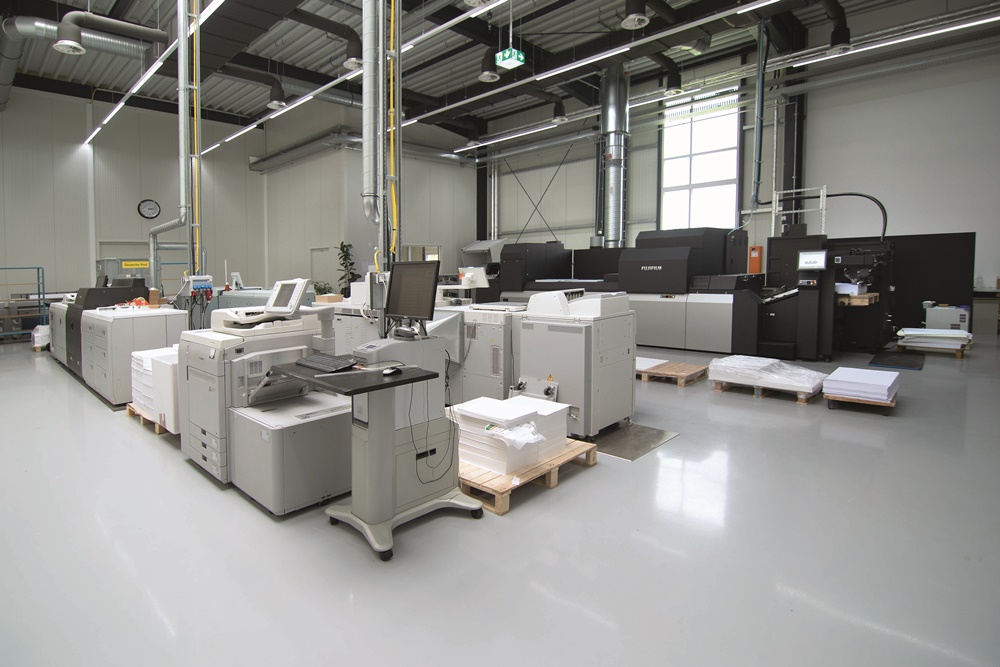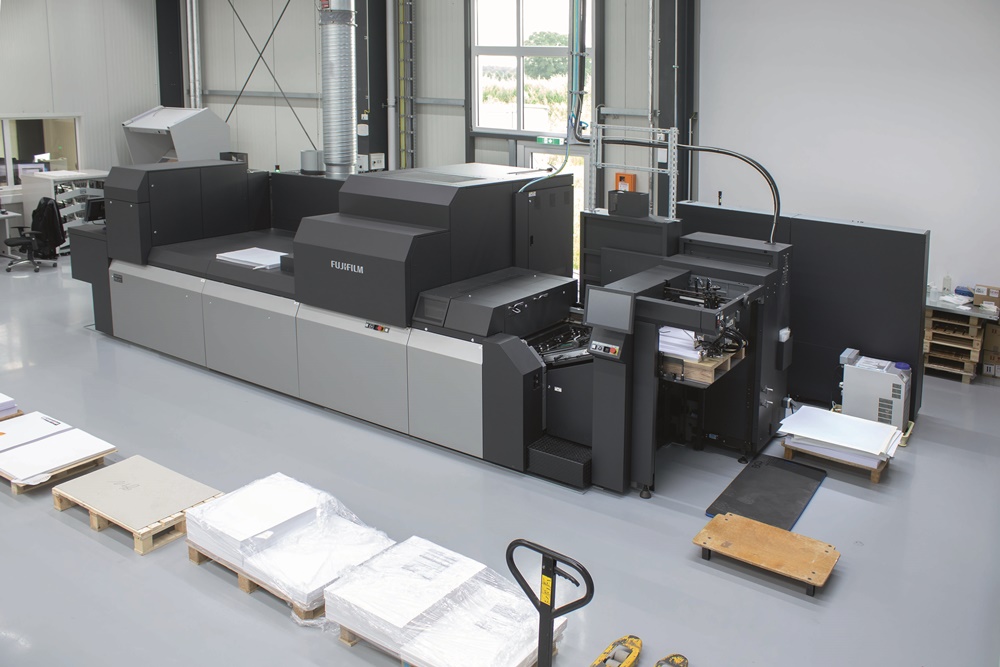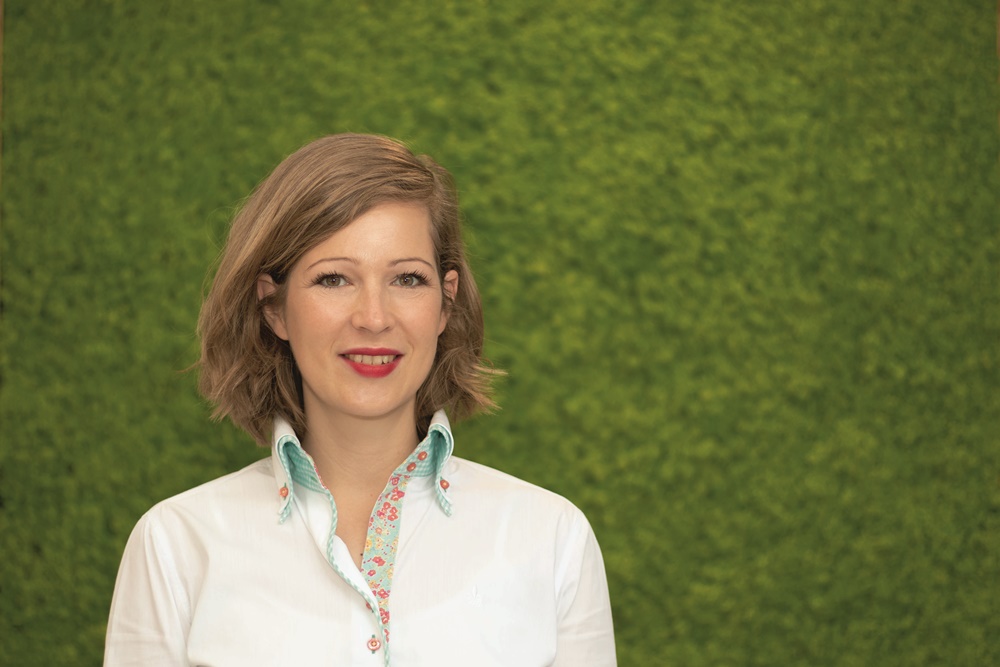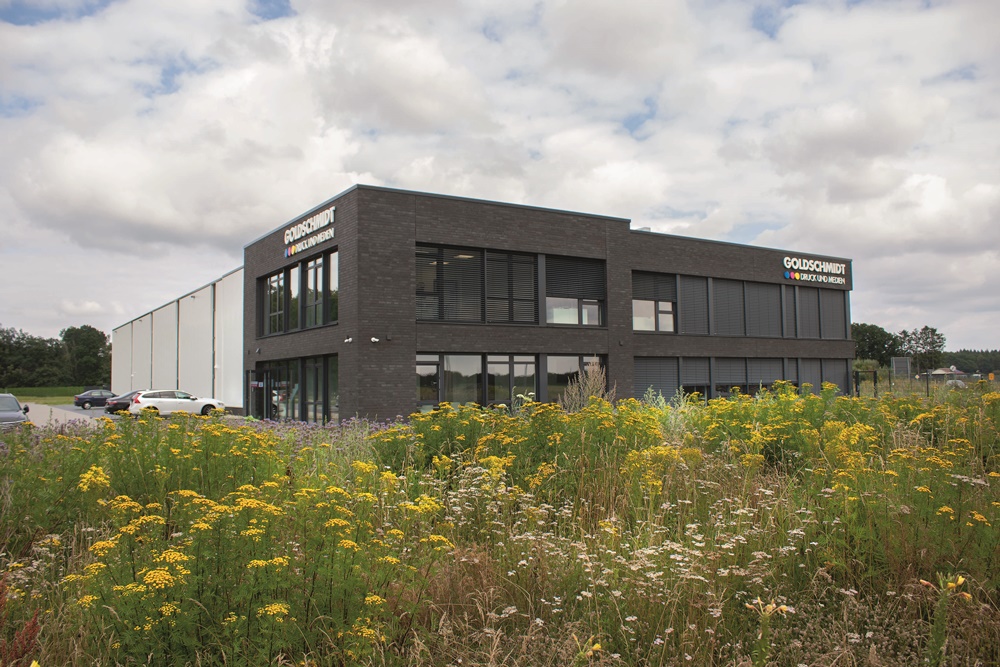P3 7-8/2021 en
Vera Goldschmidt
“Honesty With Customers is Extremely Important”
Industry Interview
How they could dare to invest a lot of money in a new building and a machine conversion under such unforeseeable circumstances was a question that the employees of the Goldschmidt print shop in Werlte in Emsland often heard in the first year of the pandemic. But these steps had been planned well in advance - and pursued goals that were perfectly in line with the changed situation. In an interview, Vera Goldschmidt, third-generation managing director of the company, talks about the background, reservations, as well as orientation and restructuring in an increasingly challenging economic environment.
The employees were also involved in the decision to purchase a Jet Press 750S.
Ms. Goldschmidt, let's start at the beginning: Please tell us something about the history of the print shop.
“Ruckzuck – Goldschmidt Druck” was the catchy advertising slogan that my grandfather Emil Goldschmidt came up with. He founded the company in Werlte in 1950. He was a master printer and typesetter and started out with a small machine in the backyard that included a book and stationery store. The business grew slowly, and when my father Wilhelm Goldschmidt joined the company in the 1970s, they moved into a new building in the industrial area. Under his management, the print shop developed into an up-and-coming, medium-sized company. In the 1990s he set up another location in Schwerin, which we still operate there today. In 2003, a location in Emsland was added through the takeover of “Van Acken Druck GmbH” in Lingen.
My career in our family business began in 2013. I have been managing director since January 2016, together with my father. So I now represent the 3rd generation. In April 2021 we moved into a modern new building in Werlte, which combines the two Emsland locations. We are a fully integrated printing company with a media department, offset and digital printing and an advertising technology department. We mainly supply customers in the B2B sector, but we also have a branch for private customers.
What does the print shop's portfolio currently look like and where do you see particular strengths compared to the competition?
We are extremely broadly based, basically we supply our customers with just about everything that can be printed or printed to. According to the motto “Nothing is impossible”, we supply the customer holistically, whether it is printed matter, advertising material or advertising technology products. Customers receive good and honest advice from us and find in us a contact person from whom they can obtain almost everything in the print sector. We are very flexible towards the customer, so that we can react quickly and reliably.
The pandemic has turned a lot of what previously seemed obvious upside down, hitting the printing industry particularly hard. What experiences have you been able to gather in the last two years and how have you dealt with them?
We also had to struggle with a drop in sales, in particular advertising measures and program booklets for events, printed matter for trade fairs or invitations from private customers have almost completely disappeared. I am therefore very happy that we have restructured our company significantly during this time. This step had been planned since 2017 and was implemented from the beginning of 2020. The core of these measures was our new building in Werlte, which was to combine production from both houses (Werlte and Lingen). Construction began in April 2020, exactly during the first lockdown. We were often asked how we could dare to invest a lot of money in a new building in such times, since the general situation is so unmanageable and unpredictable. In hindsight, going through with the project was the right thing to do. If we were to start construction now, we would have to reckon with significantly higher costs and longer construction times. In addition, we had aimed for the construction for good reasons: Saving costs by merging two production sites (leases, energy costs), which also results in a better workflow and a clearer overview. After exactly one year of construction, we were able to move. I'm 100% sure it was the right decision and the perfect timing.
With the correspondingly clouded economic outlook in mind, the print shop has invested in a Jet Press 750S from Fujifilm (see http://www.p3-news.com/De/News/20850). That sounds like an unusual, if not brave, decision. What were the reasons for the investment and were there any dissenting voices?
In addition to the new building, our restructuring measure also included a machine conversion. At the Lingen location, we operated an offset machine in B1 format, among other things. However, we have not been able to fully utilize it for a long time, since the trend towards smaller runs, but more variable and varied printed matter, has been on the rise for several years. We decided to sell the large offset press and invest in a new digital system in B2 format to better adapt to our customers' needs.
Of course there were dissenting votes or at least reservations. At first my father found it difficult to part with the existing machine, which I can understand. He had invested a lot of money and was proud of the machine, with the format of which we were the only printer in our region. However, he was always very open to new technologies and quickly recognized the advantages of a new digital printing system. We made the decision together and also involved other employees. Now we are all fully behind the new machine.
Have competing products been considered? What ultimately made the difference?
Of course, we took a close look at all comparable digital printing machines in B2 format on the market. The offer is rather manageable. The decisive factor in our decision to go with the Jetpress was the combination of quality, price and sustainability reasons. This refers to the water-based inks, which are proven to be better deinkable than the competitor's products. We also liked the good cooperation with Fujifilm. We were closely accompanied and a fair partnership was formed.
Was there at any time the fear that the shot could backfire?
In the run-up, you certainly think a lot about whether the decisions you are making are right or what problems could arise. It was crucial to involve the employees involved, to listen to their opinions and not just toss a machine in their face. We talked to colleagues well in advance whether they could even imagine working on such a digital printing system. In principle, digital printing is nothing new for us, we have been working with it for over 20 years. However, the inkjet technology and the make are certainly something new for us, and the employees first had to be trained.
After several discussions and inspections of the machine in another print shop, it quickly became clear that one of our experienced offset printers, who had previously worked on the large machine, was very open to the new technology. Another very young colleague from the media department was also enthusiastic about it. Now two colleagues with very different backgrounds and from two completely different generations operate the machine with a lot of commitment and complement each other perfectly.
In the meantime, there are new challenges to be overcome: paper shortages, especially in the graphic paper sector, rising energy and freight costs, problems with the reliability of supply chains ... What do you think is the best way to deal with such a situation? And: How much honesty can customers tolerate?
We have no choice but to make the best of the situation. We have to accept that the market is changing, adapt to it and sensitize our customers so that they follow the path.
Especially in such a difficult situation, honesty towards the customer is extremely important. Because the increasing paper prices and delivery delays are known to many through the press, or because there are similar problems in many industries, most customers understand the higher costs. When submitting an offer or when placing an order, we immediately point out to our customers that they have to reckon with higher prices and longer delivery times, as acceptance is then significantly higher. I'm sometimes amazed at how little resistance there is in general, probably because many things are becoming more expensive at the moment.
“Print is becoming more expensive” - that was one of the core statements of the year-end meeting of the Board of Directors of the Bavarian Printing and Media Association (VDMB). Do you think this is a problematic but understandable conclusion?
Yes, unfortunately that is the logical consequence of these factors. There is a great danger that customers will think twice about whether they should still have their printed matter produced at all, or whether they would rather go digital. As a result, our industry continues to lose volume. This was exacerbated even further by the pandemic.
But I also believe that you can see opportunities in such a crisis. Perhaps less will be printed, but more consciously. I am counting on customers placing more value on individuality, quality and special features in the future, choosing more special paper and wanting smaller runs. The aspect of sustainable printing is also playing an increasingly important role. We are FSC-certified, print climate-neutrally, generate electricity from our own photovoltaic system, use the waste heat from the machines and have greatly reduced our waste by switching to digital printing.
This is exactly what we have prepared for, so I see ourselves well prepared for the future.
Ms. Goldschmidt, thank you very much for the interview!

The Goldschmidt print shop is FSC-certified, prints climate-neutrally and draws its electricity from its own photovoltaic system.
Author: sbr
Images: Goldschmidt GmbH









